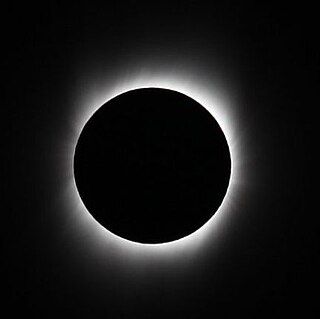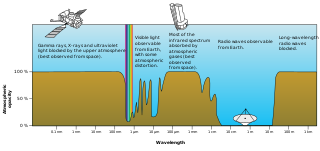
An eclipse is an astronomical event that occurs when an astronomical object or spacecraft is temporarily obscured, by passing into the shadow of another body or by having another body pass between it and the viewer. This alignment of three celestial objects is known as a syzygy. An eclipse is the result of either an occultation or a transit. A "deep eclipse" is when a small astronomical object is behind a bigger one.

A lunar eclipse is an astronomical event that occurs when the Moon moves into the Earth's shadow, causing the Moon to be darkened. Such an alignment occurs during an eclipse season, approximately every six months, during the full moon phase, when the Moon's orbital plane is closest to the plane of the Earth's orbit.

The Moon is Earth's only natural satellite. It orbits at an average distance of 384,400 km (238,900 mi), about 30 times Earth's diameter. The Moon always presents the same side to Earth, because gravitational pull has locked its rotation to the planet. This results in the lunar day of 29.5 Earth days matching the lunar month. The Moon's gravitational pull – and to a lesser extent the Sun's – are the main drivers of the tides.

In astronomy, the new moon is the first lunar phase, when the Moon and Sun have the same ecliptic longitude. At this phase, the lunar disk is not visible to the naked eye, except when it is silhouetted against the Sun during a solar eclipse.

In astronomy, a conjunction occurs when two astronomical objects or spacecraft appear to be close to each other in the sky. This means they have either the same right ascension or the same ecliptic longitude, usually as observed from Earth.

A transient lunar phenomenon (TLP) or lunar transient phenomenon (LTP) is a short-lived change in light, color or appearance on the surface of the Moon. The term was created by Patrick Moore in his co-authorship of NASA Technical Report R-277 Chronological Catalog of Reported Lunar Events, published in 1968.

An occultation is an event that occurs when one object is hidden from the observer by another object that passes between them. The term is often used in astronomy, but can also refer to any situation in which an object in the foreground blocks from view (occults) an object in the background. In this general sense, occultation applies to the visual scene observed from low-flying aircraft when foreground objects obscure distant objects dynamically, as the scene changes over time.

In astronomy, an extraterrestrial sky is a view of outer space from the surface of an astronomical body other than Earth.

A total solar eclipse occurred at the Moon's descending node of the orbit on July 22, 2009, with a magnitude of 1.07991. It was the longest total solar eclipse during the 21st century; the longest total solar eclipse during the 3rd millennium will be on 16 July 2186. It lasted a maximum of 6 minutes and 38.86 seconds off the coast of Southeast Asia, causing tourist interest in eastern China, Pakistan, Japan, India, Nepal and Bangladesh. Its greatest magnitude was 1.07991, occurring only 6 hours, 18 minutes after perigee, with greatest eclipse totality lasting 6 minutes, 38.86 seconds during the Total Solar Eclipse of July 22, 2009.

Visible-light astronomy encompasses a wide variety of astronomical observation via telescopes that are sensitive in the range of visible light. Visible-light astronomy is part of optical astronomy, and differs from astronomies based on invisible types of light in the electromagnetic radiation spectrum, such as radio waves, infrared waves, ultraviolet waves, X-ray waves and gamma-ray waves. Visible light ranges from 380 to 750 nanometers in wavelength.

A solar eclipse occurs when the Moon passes between Earth and the Sun, thereby obscuring the view of the Sun from a small part of the Earth, totally or partially. Such an alignment occurs approximately every six months, during the eclipse season in its new moon phase, when the Moon's orbital plane is closest to the plane of the Earth's orbit. In a total eclipse, the disk of the Sun is fully obscured by the Moon. In partial and annular eclipses, only part of the Sun is obscured. Unlike a lunar eclipse, which may be viewed from anywhere on the night side of Earth, a solar eclipse can only be viewed from a relatively small area of the world. As such, although total solar eclipses occur somewhere on Earth every 18 months on average, they recur at any given place only once every 360 to 410 years.
Ashen light is a hypothesised subtle glow that has been claimed to be seen on the night side of the planet Venus. The phenomenon has not been scientifically confirmed, and theories as to the observed phenomenon's cause are numerous, such as emission of light by Venus, or optical phenomena within the observing telescope itself. A modern hypothesis as to the source of light on Venus suggests it to be associated with lightning, for which there is some evidence on Venus. This theory has fallen out of favour, however, as there is not enough light generated by this lightning so as to be observed. A more recent hypothesis is that it is a form of transient aurorae or airglow caused by unusually high solar activity interacting with the upper Venusian atmosphere.

A total lunar eclipse occurred on February 20 and February 21, 2008. It was visible in the eastern evening sky on February 20 for all of North and South America, and on February 21 in the predawn western sky from most of Africa and Europe. Greatest Eclipse occurring on Thursday, February 21, 2008, at 03:26:03 UTC, totality lasting 49 minutes and 45.6 seconds.

A total lunar eclipse took place on 10 December 2011. It was the second of two total lunar eclipses in 2011, the first having occurred on June 15. A lunar eclipse occurs when the Moon is positioned just right in its orbit to pass through Earth's shadow.

A total lunar eclipse occurred on Tuesday, 8 November 2022. The southern limb of the Moon passed through the center of the Earth's shadow. It surpassed the previous eclipse as the longest total lunar eclipse visible from nearly all of North America since 17 August 1989, and until 26 June 2029. Occurring only 5.8 days before apogee, the Moon's apparent diameter was smaller. The next total lunar eclipse will take place on 14 March 2025. A lunar occultation of Uranus happened during the eclipse. It was the first total lunar eclipse on Election Day in US history. This event was referred in media coverage as a "beaver blood moon".

A partial lunar eclipse occurred on 19 November 2021. The eclipse occurred towards a micromoon. This was the longest partial lunar eclipse since 18 February 1440, and the longest until 8 February, 2669; however, many eclipses, including the November 2022 lunar eclipse, have a longer period of umbral contact at next to 3 hours 40 minutes. It was often referred to as a "Beaver Blood Moon" although not technically fulfilling the criteria for a true blood moon (totality).
International Observe the Moon Night is an annual public outreach event sponsored by the Lunar Reconnaissance Orbiter mission, the Solar System Exploration Division at NASA's Goddard Space Flight Center, and other NASA and astronomical organizations that encourages observation, appreciation, and understanding of the Moon and its connection to planetary science and exploration. Everyone on Earth is invited to join the celebration by hosting or attending an event or participating as a lunar observer — and uniting on one day each year to look at and learn about the Moon together. First organized in 2010, there are usually over 500 events annually in over 40 countries, hosted by universities, observatories, NASA Centers, schools, museums, parks, libraries, and amateur astronomers. Some events are offered both in person and via internet streaming video. The date is selected to enhance visibility of lunar topography.

In astronomy, a syzygy is a roughly straight-line configuration of three or more celestial bodies in a gravitational system.

Petr Horálek is a Czech astrophotographer, popularizer of astronomy and an artist.















